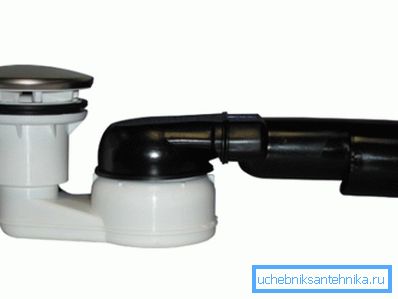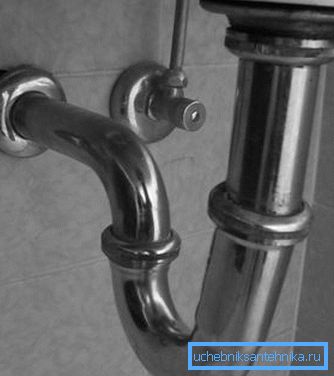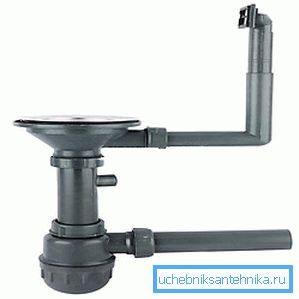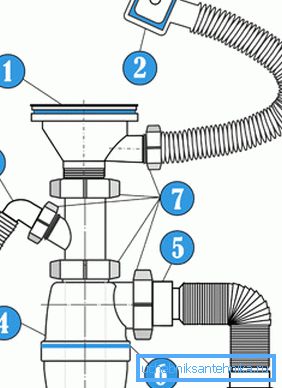Siphon for a sink - how to choose and install this node
The device for the drainage system from bathrooms and sinks is a very important part of the work, as any errors can lead to improper functioning of the devices and the penetration of an unpleasant odor into the room. It should be noted that there are different designs that can be adapted to different conditions of use, for example, a flat siphon for washing is suitable for conditions of limited space.
It is important to choose the best option for your kitchen, and we will pay attention to this issue in this article.

Basic product options
Siphon under the sink can be made of various materials, we consider the most common options and determine their main advantages and disadvantages:
| Cast iron | Such nodes can be found where the designs were assembled many years ago. This option was widely used several decades ago, but is not currently in demand, as cast-iron systems are impractical, difficult to repair and maintain. In addition, they very quickly form a raid, which leads to the need for periodic cleaning and washing |
| Brass | This option has its own characteristics, brass siphons are distinguished by high reliability, durability and resistance to deformation effects. It is quite widespread, although the price is high. You can find a variety of options, including chrome-plated surface. |
| Plastic | This type of product is the most popular these days, and it is not surprising, because it has a number of advantages: low cost, resistance to fungi and mold, non susceptibility to corrosion and rotting. In addition, due to the smoothness of the inner walls, the accumulation on them is much slower, due to this the structure needs to be cleaned much less often. The only drawback is low resistance to high temperatures, boiling water cannot be poured into the system. |
| Stainless steel | The most reliable and durable option, which is characterized by a long service life, resistance to various adverse effects and resistance to deformation. The biggest disadvantage is the high cost, which is why such systems are most often used in catering establishments where reliability is important. |

Tip! Plastic or brass are best for the home, so we advise you to choose between these two solutions.
Types of structures and recommendations for the work
There are a huge number of options on the market, so you should consider the most common ones. In addition, to assemble the structure with your own hands, you need to know the basic recommendations and familiarize yourself with the tips provided by the assembly instructions.
Main types of systems
Most often in the houses and apartments of our country you can find the following options:
- Corrugated siphons are extremely simple, you will not have a question about how to assemble the structure correctly, because it consists of a hose that bends in the middle to create a hydraulic valve. Everything is very simple, but there is one big drawback - such nodes often become clogged, and you will have to periodically clean and maintain it so that the system does not clog.

- Bottle designs have a system in which the presence of a sump in the form of a bottle. The assembly scheme of the siphon for washing is much more complicated, but the quality of work is much higher: the design is much less prone to blockages, it is very easy to clean, you just need to unscrew the bottom cover and remove all unnecessary.

- If there is an overflow in the sink, then the descent system must be appropriate. It differs from the standard modification in that there is a specific drain in it, which in the case of filling the sink will drain the water through a special channel. This option allows you to protect your kitchen and neighbors from the bottom of flooding.

- Double sink siphon is used where two sinks are installed, or one design with two bowls. It differs in that the design consists of two descents that work through one siphon, it is very convenient and allows you to save space.

- An air gap siphon under the sink is most often used in catering establishments and, where it is very important that bacteria cannot penetrate from the sewage system into the sink. The system is a node in which the outlet from the sink is not solid, but consists of two parts, and the distance between the elements should be about 2 cm. To prevent splashing, the receiving part of the siphon is made in the shape of a funnel.

Installation recommendations
Consider how to install a siphon at the sink, and although the work is simple, you should still remember a few important rules:
- When buying, always carefully check the completeness of the siphon, it should contain all the necessary gaskets and other components. There should also be an assembly instruction in which the location of each of the elements should be indicated schematically.
- The drain grille is attached first. It is sealed with gaskets on both sides of the sink, they must be elastic and smooth. Pay special attention to the location of the sealing rings, they should be strictly in the center, without offsets and distortions.

- If the structure has an overflow, then it must be installed after the drain element, the structure is fixed on the sink through a rubber gasket, and attached to the bottom with a clamping nut, under which there must be a rubber gasket.
- Next, going to the water seal, which consists of a body and the bottom cover, the elements are interconnected. Naturally, all joints are sealed with rubber rings and gently clamped.
Tip! Carefully check the condition of all threaded connections, they should not be burrs and nods. Also inspect and gaskets - rubber should be homogeneous, without cracks and other damage.
- At last, all other connections are clamped and the construction can be used, as you can see installing the siphon on the sink is easier than it seems, but it is important to check the connections for tightness at the end of the assembly.
Conclusion
The right choice of siphon is as important as its high-quality and qualified installation. The video in this article will help to better understand the features of some of the works and will allow you to understand the topic even better.